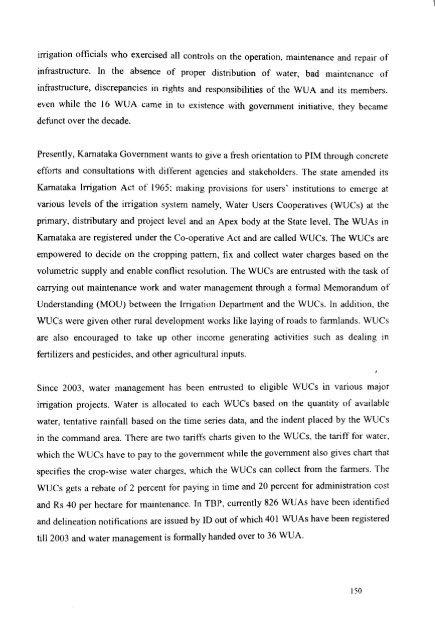Water Users Association and Irrigation Management - Institute for ...
Water Users Association and Irrigation Management - Institute for ...
Water Users Association and Irrigation Management - Institute for ...
Create successful ePaper yourself
Turn your PDF publications into a flip-book with our unique Google optimized e-Paper software.
irrigation officials who exercised all controls on the operation, maintenance <strong>and</strong> repair of<br />
infrastructure. In the absence of proper distribution of water, bad maintenance of<br />
infrastructure, discrepancies in rights <strong>and</strong> responsibilities of the WUA <strong>and</strong> its members.<br />
even while the 16 WUA came in to existence with government initiative, they became<br />
defunct over the decade.<br />
Presently, Karnataka Government wants to give a fresh orientation to PIM through concrete<br />
ef<strong>for</strong>ts <strong>and</strong> consultations with different agencies <strong>and</strong> stakeholders. The state amended its<br />
Karnataka <strong>Irrigation</strong> Act of 1965; making provisions <strong>for</strong> users' institutions to emerge at<br />
various levels of the irrigation system namely, <strong>Water</strong> <strong>Users</strong> Cooperatives (WUCs) at the<br />
primary, distributary <strong>and</strong> project level <strong>and</strong> an Apex body at the State level. The WUAs in<br />
Karnataka are registered under the Co-operative Act <strong>and</strong> are called WUCs. The WUCs are<br />
empowered to decide on the cropping pattern, fix <strong>and</strong> collect water charges based on the<br />
volumetric supply <strong>and</strong> enable conflict resolution. The WUCs are entrusted with the task of<br />
carrying out maintenance work <strong>and</strong> water management through a <strong>for</strong>mal Memor<strong>and</strong>um of<br />
Underst<strong>and</strong>ing (MOU) between the <strong>Irrigation</strong> Department <strong>and</strong> the WUCs. In addition, the<br />
WUCs were given other rural development works like laying of roads to farml<strong>and</strong>s. WUCs<br />
are also encouraged to take up other income generating activities such as dealing in<br />
fertilizers <strong>and</strong> pesticides, <strong>and</strong> other agricultural inputs.<br />
Since 2003, water management has been entrusted to eligible WUCs in vanous major<br />
irrigation projects. <strong>Water</strong> is allocated to each WUCs based on the quantity of available<br />
water, tentative rainfall based on the time series data, <strong>and</strong> the indent placed by the WUCs<br />
in the comm<strong>and</strong> area. There are two taritIs charts given to the WUCs, the tariff <strong>for</strong> water,<br />
which the WUCs have to pay to the government while the government also gives chart that<br />
specifies the crop-wise water charges, which the WUCs can collect from the farmers. The<br />
WUCs gets a rebate of 2 percent <strong>for</strong> paying in time <strong>and</strong> 20 percent <strong>for</strong> administration cost<br />
<strong>and</strong> Rs 40 per hectare <strong>for</strong> maintenance. In TBP, currently 826 WUAs have been identified<br />
<strong>and</strong> delineation notifications are issued by ID out of which 401 WUAs have been registered<br />
till 2003 <strong>and</strong> water management is <strong>for</strong>mally h<strong>and</strong>ed over to 36 WUA.<br />
150
















